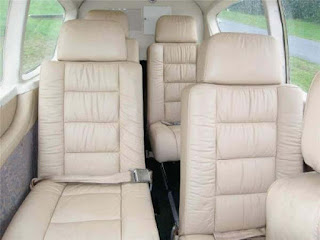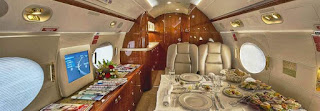The Piper Aztec can seat up to 4-6 passengers very comfortably.
https://centraljetcharter.com/piper-aztec.html
"Piper Aztec Airplane, Information!"
When Cessna would come out with a new model, the other two members of GA's Big Three would develop a model that would carry more, go faster, go farther or whatever.
Case in point: when Cessna upgraded its 310, Piper countered by adding a fifth seat and bigger engines to its Apache, thus creating the PA-23-250 Aztec.
The first really big change came about in 1962, when Piper introduced the Aztec B.
With its longer nose and bigger cabin—now with room for a sixth seat—the B model ushered in the big, brawny, beefy Aztec look that everyone is familiar with today.
Two years later, Piper again enhanced the model's appearance and performance and brought out the Aztec C.
Produced between 1964 and 1968 and featuring streamlined engine nacelles, it was by far the most popular of the Aztecs.
Standard equipment on Aztec C airplanes included fiberglass gear doors, fuel injection, dual alternators and more.
The Aztec D offered pilots a standardized instrument panel and changes to the controls in 1969.
Factory-option turbos gave the aircraft a top speed of 250 mph at 24,000 feet. Turbos were first introduced by the factory in 1965.
In 1970, the company introduced the Aztec E model with its stretched, more pointed nose.
While the new nose looked cool, reports are that the cosmetic refinement actually came with a 100-pound reduction in the useful load.
The F model, which would turn out to be the last of the Aztec lineage, was produced from 1975 through 1981.
In total almost 5,000 Aztecs were built over its 21-year production run.
While the Aztec, like its competition, was continually "improved" over the years, it never really changed much.
Then as now, it's an honest airplane that gives you the ability to pretty much fill the seats, fill the tanks and take off.
And those very attributes are why Mark Matheson has made the Piper Aztec his airplane of choice for business and personal flying.
A steel tubular airframe that's incredibly strong and resistant to the corrosion issues plaguing other aircraft of that era.
It also comes with six-place factory oxygen and has a big panel that offers enough room for advanced avionics.
It's a true six-passenger aircraft that still allows for plenty of fuel, or it can carry four passengers with baggage and full fuel.
Single-engine performance is exceptional. It'll climb at full gross weight—and the single-engine service ceiling is above the minimum en route altitude for mountain flying.
There's plenty of speed: an Aztec flies at 200-plus ktas if you want to burn fuel, but pull the throttles back to 170 and it will burn 32 gph total.
The plane has de-icing boots on its leading edges, de-icing for the props and a heated windshield.
Today, more than 30 years on, it continues to provide comfortable personal transportation and to labor honestly in the vineyards of commercial Aviation.
The Piper Aztec Private Aircraft offers many students their introduction to the challenges of multi-engine flight, where, like any good instructor, the Aztec is a gentle and reliable friend.
While its maximum and cruise speeds compare favorably with the swiftest competitor, the short, thick wing permits slow and safe air-speeds.
"Private Charter Airplane, The Piper Aztec!"
"Piper Aztec Airplane, Information!"
When Cessna would come out with a new model, the other two members of GA's Big Three would develop a model that would carry more, go faster, go farther or whatever.
Case in point: when Cessna upgraded its 310, Piper countered by adding a fifth seat and bigger engines to its Apache, thus creating the PA-23-250 Aztec.
The first really big change came about in 1962, when Piper introduced the Aztec B.
With its longer nose and bigger cabin—now with room for a sixth seat—the B model ushered in the big, brawny, beefy Aztec look that everyone is familiar with today.
Two years later, Piper again enhanced the model's appearance and performance and brought out the Aztec C.
Produced between 1964 and 1968 and featuring streamlined engine nacelles, it was by far the most popular of the Aztecs.
Standard equipment on Aztec C airplanes included fiberglass gear doors, fuel injection, dual alternators and more.
The Aztec D offered pilots a standardized instrument panel and changes to the controls in 1969.
Factory-option turbos gave the aircraft a top speed of 250 mph at 24,000 feet. Turbos were first introduced by the factory in 1965.
In 1970, the company introduced the Aztec E model with its stretched, more pointed nose.
While the new nose looked cool, reports are that the cosmetic refinement actually came with a 100-pound reduction in the useful load.
The F model, which would turn out to be the last of the Aztec lineage, was produced from 1975 through 1981.
In total almost 5,000 Aztecs were built over its 21-year production run.
While the Aztec, like its competition, was continually "improved" over the years, it never really changed much.
Then as now, it's an honest airplane that gives you the ability to pretty much fill the seats, fill the tanks and take off.
And those very attributes are why Mark Matheson has made the Piper Aztec his airplane of choice for business and personal flying.
A steel tubular airframe that's incredibly strong and resistant to the corrosion issues plaguing other aircraft of that era.
It also comes with six-place factory oxygen and has a big panel that offers enough room for advanced avionics.
It's a true six-passenger aircraft that still allows for plenty of fuel, or it can carry four passengers with baggage and full fuel.
Single-engine performance is exceptional. It'll climb at full gross weight—and the single-engine service ceiling is above the minimum en route altitude for mountain flying.
There's plenty of speed: an Aztec flies at 200-plus ktas if you want to burn fuel, but pull the throttles back to 170 and it will burn 32 gph total.
The plane has de-icing boots on its leading edges, de-icing for the props and a heated windshield.
Today, more than 30 years on, it continues to provide comfortable personal transportation and to labor honestly in the vineyards of commercial Aviation.
The Piper Aztec Private Aircraft offers many students their introduction to the challenges of multi-engine flight, where, like any good instructor, the Aztec is a gentle and reliable friend.
While its maximum and cruise speeds compare favorably with the swiftest competitor, the short, thick wing permits slow and safe air-speeds.
"Private Charter Airplane, The Piper Aztec!"




Private Aircraft charter in the Piper Aztec.
ReplyDeletePiper Aztec at any time in any place, with just one call.
ReplyDeletePlease contact us for your next trip.
ReplyDeleteWe would love to hear from you.
ReplyDeletelike
ReplyDelete
ReplyDeleteWe specialize in private aircraft charter.